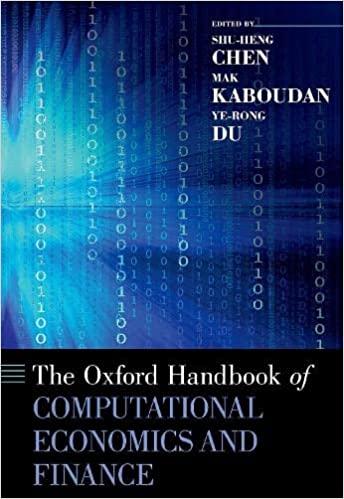Question
1. River Cruises is all-equity-financed with 100,000 shares. It now proposes to issue $220,000 of debt at an interest rate of 12% and use the
1. River Cruises is all-equity-financed with 100,000 shares. It now proposes to issue $220,000 of debt at an interest rate of 12% and use the proceeds to repurchase 22,000 shares at $10 per share. Profits before interest are expected to be $122,000.
a. What is the ratio of price to expected earnings for River Cruises before it borrows the $220,000? (Do not round intermediate calculations. Round your answer to 2 decimal places.)
b. What is the ratio after it borrows? (Do not round intermediate calculations. Round your answer to 2 decimal places.)
2.
River Cruises is all-equity-financed.
| Current Data | |||||||||
| Number of shares | 100,000 | ||||||||
| Price per share | $ | 10 | |||||||
| Market value of shares | $ | 1,000,000 | |||||||
| State of the Economy | |||||||||
| Slump | Normal | Boom | |||||||
| Profits before interest | $ | 82,750 | 140,500 | 202,000 | |||||
Suppose it now issues $250,000 of debt at an interest rate of 10% and uses the proceeds to repurchase 25,000 shares. Assume that the firm pays no taxes and that debt finance has no impact on firm value. Refer to the above table to compute the missing data. (Do not round intermediate calculations. Round "Earnings per share" to 3 decimal places. Enter "Return on shares" as a percent rounded to 2 decimal places.)
River Cruises is all-equity-financed.
| Current Data | |||||||||
| Number of shares | 100,000 | ||||||||
| Price per share | $ | 10 | |||||||
| Market value of shares | $ | 1,000,000 | |||||||
| State of the Economy | |||||||||
| Slump | Normal | Boom | |||||||
| Profits before interest | $ | 82,750 | 140,500 | 202,000 | |||||
Suppose it now issues $250,000 of debt at an interest rate of 10% and uses the proceeds to repurchase 25,000 shares. Assume that the firm pays no taxes and that debt finance has no impact on firm value. Refer to the above table to compute the missing data. (Do not round intermediate calculations. Round "Earnings per share" to 3 decimal places. Enter "Return on shares" as a percent rounded to 2 decimal places.)
| |||||||||||||||||||||||||||||||||||||||||||||||||||||||||||||||||||||||||||||||||||||||||||
3 .
Suppose that you own 2,500 shares of Nocash Corp. and the company is about to pay a 25% stock dividend. The stock currently sells at $100 per share.
a. What will be the number of shares that you hold after the stock dividend is paid? (Do not round intermediate calculations.)
b. What will be the total value of your equity position after the stock dividend is paid? (Do not round intermediate calculations.)
c. What will be the number of shares that you hold if the firm splits five-for-four instead of paying the stock dividend?
4.
Consolidated Pasta is currently expected to pay annual dividends of $10 a share in perpetuity on the 1.4 million shares that are outstanding. Shareholders require a rate of return of 8% from Consolidated stock.
a. What is the price of Consolidated stock? (Do not round intermediate calculations.)
b. What is the total market value of its equity? (Enter your answer in millions.)
Consolidated now decides to increase next years dividend to $20 a share, without changing its investment or borrowing plans. Thereafter the company will revert to its policy of distributing $10 million a year.
c. How much new equity capital will the company need to raise to finance the extra dividend payment? (Enter your answer in millions.)
5.
The expected pretax return on three stocks is divided between dividends and capital gains in the following way:
| Stock | Expected Dividend | Expected Capital Gain |
| A | $0 | $10 |
| B | 5 | 5 |
| C | 10 | 0 |
a. If each stock is priced at $155, what are the expected net percentage returns on each stock to (i) a pension fund that does not pay taxes, (ii) a corporation paying tax at 45% (the effective tax rate on dividends received by corporations is 10.5%), and (iii) an individual with an effective tax rate of 10% on dividends and 5% on capital gains? (Do not round intermediate calculations. Enter your answers as a percent rounded to 2 decimal places.)
| |||||||||||||||||||||||||||||
b. Suppose that investors pay 40% tax on dividends and 10% tax on capital gains. If stocks are priced to yield an after-tax return of 10%, what would A, B, and C each sell for? Assume the expected dividend is a level perpetuity. (Do not round intermediate calculations. Round your answers to 2 decimal places.)
|
Step by Step Solution
There are 3 Steps involved in it
Step: 1

Get Instant Access to Expert-Tailored Solutions
See step-by-step solutions with expert insights and AI powered tools for academic success
Step: 2

Step: 3

Ace Your Homework with AI
Get the answers you need in no time with our AI-driven, step-by-step assistance
Get Started


